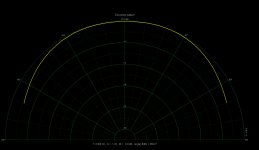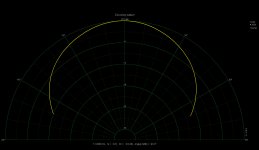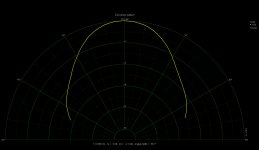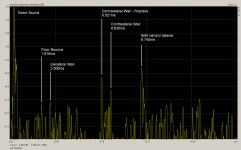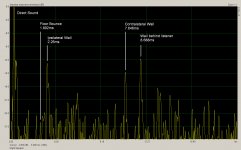I'm not referring to a dip in power response though. My crossover frequency is at 4Khz, so the overall power response dip of the speaker (combined crossover and midbass driver directivity) occurs at 3Khz. Even an 8" driver is not "beaming" at 1Khz.Even many conventional cone + dome 2-ways have a dip in power response in that transitional range.
In my own free interpretation this may enforce a "front oriented" impression, but also hamper
"spacious" impression. Due to beaming of the 2-way's woofer, you would have to introduce an
on axis hump in this range to provide flat power response ...
That hump caused by directional radiation from the front may also contradict the
"default spectral interpretation" (which is "rear") of pronounced intensity in that range.
Severe coloration (subjectively) would be the price for flattening the power response
of such a 2-way. So one is better off introducing a dip in the power response.
"Flatness on axis" can't be the only issue involed, because you could compensate for beaming of
the woofer by more/less/no toeing in as well. But that doesn't work as well due to my own experience,
the comon 2-way (2 ... 2,5 Khz crossover) will usually have (need) that dip in power response.
I'm referring to a total response dip (on axis and off axis) at 1Khz caused by surround anti-phase resonance, and correcting the on axis response with EQ also corrects the off axis and power response, so we're not talking about a difference between on axis response and power response.
Supplement to my post above:
Handling the problem of discountinuous dispersion in a 2-way below and at crossover
(of the loudspeaker) implies finding a solution which is somehow "least disturbing" in
terms of spectral cues for spatial hearing in the "rear" band.
The common manner of handling the problem (power response dip), has in turn become
a strong convention in home listening, simply because that concept of speaker
is widely spread.
There is a lot of "education" also for "naive" listeners coming from that.
Handling the problem of discountinuous dispersion in a 2-way below and at crossover
(of the loudspeaker) implies finding a solution which is somehow "least disturbing" in
terms of spectral cues for spatial hearing in the "rear" band.
The common manner of handling the problem (power response dip), has in turn become
a strong convention in home listening, simply because that concept of speaker
is widely spread.
There is a lot of "education" also for "naive" listeners coming from that.
Last edited:
I'm not referring to a dip in power response though. My crossover frequency is at 4Khz, so the overall power response dip of the speaker (combined crossover and midbass driver directivity) occurs at 3Khz. Even an 8" driver is not "beaming" at 1Khz.
Sure it is! Give it some baffle, and it will be even more pronounced.
I'm referring to a total response dip (on axis and off axis) at 1Khz caused by surround anti-phase resonance, and correcting the on axis response with EQ also corrects the off axis and power response, so we're not talking about a difference between on axis response and power response.
In my measurements the dip usually shifts a bit when looking off-axis. I probably wouldn't try and EQ it, as in most cases the audible effect of the resonance is benign.
Back on-topic:
Ignoring the most controversial ideas put forward, do we agree that when it comes to reflections at less than 10 or 20 ms we either want to:
- Minimize their magnitude and number (the reasons should be clear by now), or;
- Maximize them?
When early reflections are un-filtered and plentiful, their combined effect should not lead to excessive coloration, as the peaks and dips in the comb-filtered response are very close and many fall into one critical bandwidth. You'll still have to give up some clarity, but at least you'll have spaciousness and ASW.
... Even an 8" driver is not "beaming" at 1Khz.
...
Maybe "beaming" is the wrong word but ...
Krm= ((2 pi f)/c) x rm , rm being the cone's radius
Krm approximately for driver radius = 0.1m
f..........Krm
200......0.37
400......0.74
800......1.48
1600....2.96
Using a shallow baffle
at Krm = 1 you have approx 3dB directivity index
at Krm = 2 you have approx 7dB directivity index
Directivity is significantly increasing for a 10cm radius driver
(which corresponds to 8" diameter) above say 500 Hz ...
Last edited:
...
I'm referring to a total response dip (on axis and off axis) at 1Khz caused by surround anti-phase resonance, and correcting the on axis response with EQ also corrects the off axis and power response, so we're not talking about a difference between on axis response and power response.
I see. But i suspect this being a more narrow banded issue ?
I dont think narrow banded oddities have serious influence due to
the "rear" directional band.
....Ignoring the most controversial ideas put forward, do we agree that when it comes to reflections at less than 10 or 20 ms we either want to:
- Minimize their magnitude and number (the reasons should be clear by now), or;
- Maximize them?....
Maximise them, provided they are:
- above 2-3ms delayed,
- lateral, and
- of similar spectrum to the direct sound.
...
give up some clarity, but at least you'll have spaciousness and ASW.
perhaps, there is some difficulty in that neither clarity nor spaciousness can be objectively measured
OTOH if we assume that there is this significant trade-off between clarity and spaciousness - just for the sake of the discussion - how to strike a balance between them as two important factors of quality of music reproduction? can one be prioritized over the other depending on - for example - the purpose of the listening session (eg. music production vs music enjoyment)? also - which one weighs more from perspective of realism of music reproduction?
@tnargs
basically agreed but:
why 2-3 ms? I remember You said the numbers came from Toole, where exactly from?
and ceiling
similar that is...? in other words - what are the limits of sufficient similarity?
basically agreed but:
Maximise them, provided they are:
- above 2-3ms delayed,
why 2-3 ms? I remember You said the numbers came from Toole, where exactly from?
- lateral,
and ceiling
and
- of similar spectrum to the direct sound.
similar that is...? in other words - what are the limits of sufficient similarity?
Last edited:
Really ? So the measured polar response of an 8" driver at 1Khz in the first image below is "beaming" ? 3dB down at +/- 65 degrees ? That's not my definition of beaming, by a long stretch. That was taken on a largish baffle too - 63cm x 39cm.Sure it is! Give it some baffle, and it will be even more pronounced.
People seem to greatly over estimate the directivity of large drivers.
I'm still in two minds about whether to try to EQ it or not. It's very consistent in frequency, and doesn't shift more than 50Hz or so over a wide range of angles, with the same depth as well.In my measurements the dip usually shifts a bit when looking off-axis. I probably wouldn't try and EQ it, as in most cases the audible effect of the resonance is benign.
C'mon chaps, put your formulas away and measure some actual driversMaybe "beaming" is the wrong word but ...
Krm= ((2 pi f)/c) x rm , rm being the cone's radius
Krm approximately for driver radius = 0.1m
200 0.37
400 0.74
800 1.48
1600 2.96
Using a shallow baffle
at Krm = 1 you have approx 3dB directivity index
at Krm = 2 you have approx 7dB directivity index
Directivity is significantly increasing for a 10cm radius driver
(which corresponds to 8" diameter) above say 500 Hz ...
A real driver is (a) not a flat piston but a cone, (a conical radiator has increased dispersion over a flat piston, yet the formulas for a flat idealised piston are still often used) and (b) a real cone in a wide band driver is not a rigid piston at higher frequencies - cone breakup and shrinking radiation area helps to further improve dispersion over a rigid cones theoretical response.
Compare your calculated directivity indexes and expectations to the measurements below and you'll see they don't line up. To be fair I'm cheating a bit, because its a dual cone driver, but this only starts to improve directivity over a single cone at about 2Khz and above, and isn't relevant to 1Khz.
Is it beaming at 1Khz ? Not in the slightest. At 2Khz ? I would call that directional, but not beaming as its still about 90 degrees. At 3.1Khz ? Yes, starting to beam now for sure.
Attachments
Last edited:
No. It's impossible to measure a full range driver of that size in the near-field at high frequencies and get any meaningful results. I don't remember for sure if I used half a metre or 1 metre, but looking at the relatively short reflection free time in the impulses it was probably 1 metre.DBMandrake, did you measure in the near-field?
Well, you need to place a figure on what beaming is - directivity is usually measured to -6dB, and at 1Khz it doesn't actually go as low as -6dB, even at +/- 90 degrees (not shown in the measurements) so its the baffle that's controlling the directivity at that frequency.Call it directional, call it beaming - for me that's just semantics.
If I had to put a number on it I'd say directivity of 60 degrees or less is beaming. Where you draw the dividing line is up for debate though I guess, I haven't seen a formal definition of beaming, and the shape of the lobe is probably just as important as the exact -6dB width.
That was taken on a largish baffle too - 63cm x 39cm.
If you wanted to take into account baffle-effects, you should have measured at a greater distance than half a metre or 1 meter. Now you were essentially measuring in a transition region between near- and far-field.
I've got a box and an 8" driver somewhere in my workshop, so I may do some measurements this weekend if I feel like it.
damned, this thread is going fast !
Just the opposite ! It's a stunning experiment :
1. sitting normally and listening ONLY the rear speakers, it's very difficult to say that the source is behind me, in a blind test I would say that this comes from the front (but the channels are inversed L>R by the wiring, this is obvious and recognizable).
2. if I turn my seat of 180°, always with only these back speakers running that are now in front of me, this time the source is absolutely where the speakers are.
This is done with a curve that says "sound in front", when compared to all the samples we have in memory. Demonstration : with a pink noise, the source in (1) is identified as situated in my back. And of course, if I rotate my head, the source is not any more in the median plane and is localized as it is.
sorry for the OT and the chaotic english, but it's reassuring to see that these assumptions from Blauerts are absolutely true.
Ps : DB mandrake, post 702, the DIP : I follow totally, I even believed that the mike was not linear.
Do You mean You cannot confirm that You can hear this effect?
Just the opposite ! It's a stunning experiment :
1. sitting normally and listening ONLY the rear speakers, it's very difficult to say that the source is behind me, in a blind test I would say that this comes from the front (but the channels are inversed L>R by the wiring, this is obvious and recognizable).
2. if I turn my seat of 180°, always with only these back speakers running that are now in front of me, this time the source is absolutely where the speakers are.
This is done with a curve that says "sound in front", when compared to all the samples we have in memory. Demonstration : with a pink noise, the source in (1) is identified as situated in my back. And of course, if I rotate my head, the source is not any more in the median plane and is localized as it is.
sorry for the OT and the chaotic english, but it's reassuring to see that these assumptions from Blauerts are absolutely true.
Ps : DB mandrake, post 702, the DIP : I follow totally, I even believed that the mike was not linear.
Last edited:
True, but if I measure further away than a metre I don't have enough reflection free time to get any sort of accuracy below 1Khz anyway - catch 22.If you wanted to take into account baffle-effects, you should have measured at a greater distance than half a metre or 1 meter. Now you were essentially measuring in a transition region between near- and far-field.
1Khz is well above the baffle step frequency of the cabinet though which is just under 300Hz, so it's well beyond the baffle step transition region.
If there were still baffle diffraction ripples in the response at 1Khz it would show up clearly in the polar response as a dip in the on axis response (heart shape curve) or other strange distortion to the polar response, but there is nothing like that.
graaf, you have a point here. I suggest that "clarity" is the opposite to "diffusity", and "spaciousness" is the opposite to "dryness". With dryness meaning something like very near-field recording without relevant cues of the surrounding space..perhaps, there is some difficulty in that neither clarity nor spaciousness can be objectively measured
In my experience "spaciousness" can mean two different things to different people: Some associate spaciousness with more diffusity, others rather associate spaciousness with more "black" space between separately arranged sources.OTOH if we assume that there is this significant trade-off between clarity and spaciousness - just for the sake of the discussion - how to strike a balance between them as two important factors of quality of music reproduction? can one be prioritized over the other depending on - for example - the purpose of the listening session (eg. music production vs music enjoyment)? also - which one weighs more from perspective of realism of music reproduction?
Apart from that there seem to be VERY different opinions about what is the REALISM of a music reproduction.
Rudolf
In addition to the ETCs I've shown earlier, here's the left speaker with a small piece of cardboard (20x20cm) covering the window frames:
Without the board:
An externally hosted image should be here but it was not working when we last tested it.
Without the board:
An externally hosted image should be here but it was not working when we last tested it.
Here you go. Floor plan:
An externally hosted image should be here but it was not working when we last tested it.
Nathan, right:
An externally hosted image should be here but it was not working when we last tested it.
By the way, we don't see any front wall reflections because the whole wall is absorptive. There's also a thick rug on the floor.
I've just measured ETC curves of my speakers and room for a comparison. Quite an interesting exercise.
A couple of caveats -
(1) my room is rather small and my normal listening position is quite close to the rear wall. This adds a lot of extra strong reflections in the same time range as those we're interested in, like floor, side walls etc, confusing the issue, so for the purpose of this test I've brought the measurement position about half a meter further forward to delay that rear wall reflection enough to get it out of the way.
(2) To identify each reflection source I measured with and without an absorbing blocking object (me!) in the path of the reflection, as such I wasn't able to identify the ceiling reflection due to being unable to lie on the ceiling
The room layout is significantly asymmetric, both speaker to side-wall distance, as well as room objects and damping so the differences between left and right are interesting.
The first 1.5ms looks much the same for both channels.
The floor bounce reflection comes first at around 1.8ms, and on the right speaker there is a thick rug in front of it, putting the reflection well down into the noise. I was only able to identify it by further reducing it with more adsorption/diffusion on the floor. (me again...) The left speakers floor bounce area is only partially covered by a rug and from that we see the floor bounce is about 4dB greater in level.
Next comes the ipsilateral reflection at 2.26ms on the Right and 2.6ms on the left. This is the major difference between the left and right side of the room, and amounts to a 10dB greater reflection on the right side, which is largely bare wall with a small fake fireplace a bit further along and protruding about a foot.
On the left, the speaker is a bit further from the wall, but there is also a sofa and a small computer desk along the left wall only a metre or so from the speaker, together which would add significant diffusion and absorption, with the difference being really obvious in these plots.
When I've tried to optimize the imaging in this room with toe in etc, its always the right side that has been the problematic one, and even with this amount of toe in there is still a strong reflection that could really do with diffusion.
Contralateral reflections come next, at 7.646ms for the right speaker (off the left wall) and two discrete reflections at 6.021ms and 6.635ms for the left speaker coming off the right wall. Both the latter reflections disappeared together blocking the path to that wall, so I can only assume that the wall and the protruding but flat and smooth surfaced electric fire place provide two different path lengths.
Finally at 8.68ms comes a large reflection from the wall behind the listener - which would normally come at around 4ms at the normal listening position.
It's hard to draw conclusions from different measurement set-ups/software in different rooms but apart from my strong ipsilateral reflection on the right wall, most of the early reflections look quite subdued in amplitude compared even to the Nathan speaker you measured, which I find surprising given how live the room still sounds.
Edit: I forgot you tested with them toed out. I should add that my speakers are toed in approximately 30 degrees.
Of all the reflections that correspond with the perceived impact on imaging, that early ipsilateral reflection definitely seems to be the killer, with 12dB down not being enough, and the asymmetry between left and right being a significant problem.
Attachments
Last edited:
We won't be able to agree on any preferable reflection pattern as long as we haven't agreed on the spatial and tonal attributes of the virtual musical space we want to be in. This has been the fatal gap when you asked for the IDEAL directivity pattern. Ideal for what???Back on-topic:
Ignoring the most controversial ideas put forward, do we agree that when it comes to reflections at less than 10 or 20 ms we either want to:
- Minimize their magnitude and number (the reasons should be clear by now), or;
- Maximize them?
Rudolf
Even many conventional cone + dome 2-ways have a dip in power response in that transitional range.
In my own free interpretation this may enforce a "front oriented" impression, but also hamper "spacious" impression. Due to beaming of the 2-way's woofer, you would have to introduce an on axis hump in this range to provide flat power response ...
Severe coloration (subjectively) would be the price for flattening the power response of such a 2-way. So one is better off introducing a dip in the power response.
"Flatness on axis" can't be the only issue involed, because you could compensate for beaming of the woofer by more/less/no toeing in as well. But that doesn't work as well due to my own experience, the comon 2-way (2 ... 2,5 Khz crossover) will usually have (need) that dip in power response.
Since we are back to directivity I'll throw in some measurements from Toole. I frequently re-read his original paper on listener preferences, not so much for the conclusions but to look at the data and come to my own conclusions.
http://www.aes.org/e-lib/download.cfm?ID=5270&name=harman
With careflul listening tests he had a group of listeners rank order 20+ speakers then measured many aspects of their performance.
Pertaining to desired speaker directivity would be the curves below. Toole claims that the 60 to 75 degree curve average is most relevant to the first wall reflection. The 60-75 curves shown are of the 6 top ranked systems in his test. There is considerable variation in the 1k to 4 k range simply because some are 2 way and others are 3 way systems. The 2 ways have a dip in response in the 3k region. The 3 ways have more off axis energy in the 1 or 2k region. It is hard to see a preferred off axis curve here.
The directivity index curve shows power response above (fairly close to the 60-75 curve trends), and the d.i. curve below. The units with the highest fidelity ratings generally climbed to +6dB at 500 Hz and then had great variation, again, in the 1 to 4kHz region. What is the right overall directivity required to sound good?
The last curve is all 20 speakers (I believe that several bad systems had been removed from the group) with their measured power response. Except for #3 we see that good speakers can have a considerable power response dip. Looking down the list note that #10, smack dab in the middle has a beautiful power response trend (11 and 12 aren't bad) and, almost at the bottom, #18 looks quite decent.
So Toole argues well for broad directivity but his top ranked speakers have an upper range d..i. of at least 6 dB (hemispherical response would be a d.i. of 3) and a very wide range of off axis curves.
This follows well the findings of Lipshitz and Vanderkooy that holes in system power response are fairly benign. As much as I hate to say it, it also shows that constant directivity is of no particular benefit, unless it improves the on and near-off-axis response.
What is the ideal directivity? Apparently the middling directivity of the typical 2 or 3 way forward firing design, as long as the on axis response is flat and smooth.
David S.
Attachments
- Status
- This old topic is closed. If you want to reopen this topic, contact a moderator using the "Report Post" button.
- Home
- Loudspeakers
- Multi-Way
- What is the ideal directivity pattern for stereo speakers?
